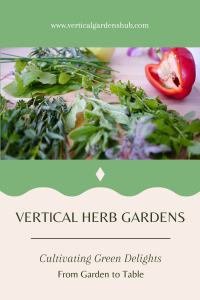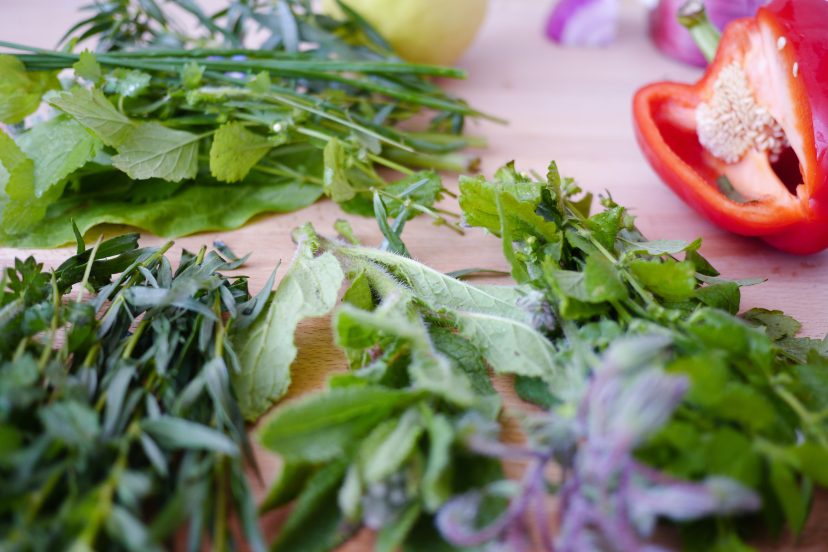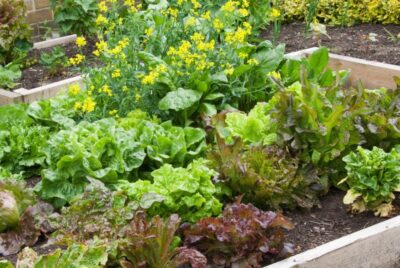Vertical Herb Garden: Cultivating Green Delights
Vertical herb gardens have taken the gardening world by storm, and for good reasons. There are many advantages to designing, planting, and nurturing your own garden of flavorful herbs.
In this Article!
- Benefits of a Vertical Herb Garden
- Selecting the Right Herbs
- Choosing the Ideal Location
- Designing Your Herb Garden
- Preparing the Growing Medium
- Planting and Caring for Your Herbs
- Herb Garden Maintenance
- Harvesting and Utilizing Your Herb Garden
- Vertical Herb Gardens in Small Spaces
- Vertical Herb Gardens as Decorative Elements
- Educational Value of Herb Gardens
- Sustainability and Environmental Impact
- Cost-Effectiveness of Vertical Herb Gardens
Benefits of a Vertical Herb Garden
Vertical herb gardens are not just about aesthetics; they’re a testament to ingenuity and resourcefulness. By embracing this vertical approach, you can enjoy a plethora of advantages that traditional gardens often struggle to provide.
Maximizing space use is a key benefit. Whether you have a small backyard or a cozy balcony, vertical herb gardens make the most of your available area. With herbs growing upwards instead of sprawling outwards, you can cultivate a diverse assortment of herbs without sacrificing valuable space.
Accessibility and maintenance become a breeze in vertical gardens. No more bending over or kneeling to tend to your plants. Each herb is within arm’s reach, ensuring effortless watering, pruning, and harvesting. This convenience also encourages you to engage with your garden regularly, fostering a deeper connection with your plants.
The visual appeal of a vibrant green tapestry against a wall or trellis is truly enchanting. Vertical gardens transform plain surfaces into living artworks, adding a touch of nature’s elegance to urban environments. Whether you’re an experienced gardener or a novice, the beauty of your vertical herb garden will captivate all who see it.
Selecting the Right Herbs 
Choosing the herbs for your vertical garden requires consideration as some herbs are bushy while others are trailing. Consider the purpose of your herbs. Are they meant to enhance your culinary creations, create herbal teas, or serve medicinal purposes, or all of the above? Think about the herbs you frequently use and love, as these will be the stars of your vertical garden.
Consider the purpose of your herbs. Are they meant to enhance your culinary creations, create soothing herbal teas, or serve medicinal purposes or all three? Basil, mint, thyme, and rosemary are popular choices, each bringing their unique flavors and benefits. Think about the herbs you frequently use and love, as these will be the stars of your vertical garden.
Choosing the Ideal Location
Now that we’ve laid the groundwork for your vertical herb garden, it’s time to find the perfect spot for it to flourish. The success of your garden hinges on the location you choose, so let’s explore the factors to consider.
Adequate sunlight exposure is crucial. Most herbs thrive in full sun, which typically translates to around 6-8 hours of direct sunlight per day. Observing your gardens sunlight patterns will help you decide the best placement for your vertical garden. If your available area doesn’t receive ample sunlight, don’t despair – there are shade-tolerant herbs that can still thrive in slightly dimmer conditions.
Shielding your herbs from harsh weather is equally important. Extreme winds or heavy downpours can damage delicate plants. Position your vertical garden in a location that offers a bit of protection, such as against a sturdy wall or near an existing structure.
For the sake of convenience, consider the proximity of your vertical herb garden to your kitchen. Placing it within arm’s reach of your culinary haven will make it effortless to snip fresh leaves while cooking up your favorite dishes.
Designing Your Vertical Herb Garden
The design of your vertical herb garden is where creativity truly shines. There are various structures to choose from, each offering its unique charm. Wall-mounted planters, hanging baskets, and trellises are all wonderful options.
As you arrange your herbs, keep in mind their growth habits. Place taller herbs like rosemary or dill towards the top, allowing them to cascade gracefully downwards. This not only maximizes the use of space but also showcases the natural beauty of each herb.
Incorporate decorative elements to add an artistic touch to your garden. Painted planters, colorful pots, or even repurposed wooden crates can infuse your vertical garden with personality. Let your imagination run wild – after all, this is your living masterpiece.
Also Read:
- Overview of Vertical Gardens
- Vertical Vegetable Gardens: 15 Best Veggies
- Vertical Vegetable Gardening
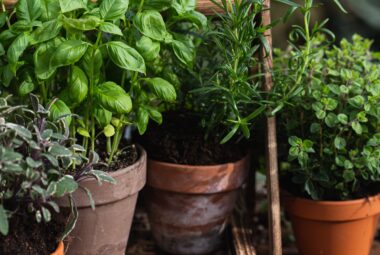 Preparing the Growing Medium
Preparing the Growing Medium
A thriving vertical herb garden starts with a well-prepared growing medium. Choose well-draining soil to prevent waterlogging, which can be detrimental to herbs. You can either buy a high-quality potting mix designed for herbs or create your blend using compost, peat moss, and perlite.
Amend the soil with compost to enrich it with essential nutrients. Herbs appreciate fertile soil that supports their rapid growth and robust flavor. Additionally, ensure the growing medium keeps moisture adequately. Coconut coir or vermiculite can help with water retention, ensuring your herbs receive the hydration they need.
Planting and Caring for Your Herbs
With the foundation of your vertical herb garden set up, it’s time to bring life to your creation through planting. Follow these steps for successful planting and nurturing of your herbs.
Transplanting seedlings or using starter plants is a convenient way to kickstart your garden. It allows you to skip the germination process and jump straight into caring for your growing herbs. Gently remove the plants from their containers, ensuring the roots are intact, and position them in their designated spots within your vertical structure.
Watering is a critical aspect of herb care. Different herbs have varying water requirements, so it’s essential to understand the needs of each plant. Generally, herbs prefer slightly moist but not waterlogged soil. Monitor the moisture levels regularly and adjust your watering routine accordingly.
Pruning and harvesting play a vital role in supporting the health and productivity of your herbs. Regularly trim back overgrown stems and spent flowers to encourage new growth. When harvesting, opt for a “cut and come again” approach – snip a few leaves from each plant rather than removing entire stems. This ensures a continuous supply of fresh herbs throughout the growing season.
Vertical Herb Garden Maintenance
To keep your vertical herb garden thriving, a consistent maintenance routine is essential. Regular fertilization is key to providing your herbs with the necessary nutrients. A balanced, water-soluble fertilizer applied every few weeks will promote healthy growth and robust flavor.
Pests and diseases can be a challenge, but proactive measures can keep them at bay. Regularly inspect your herbs for signs of trouble, such as discolored leaves or pests. Natural remedies like neem oil or insecticidal soap can effectively combat common garden pests without harming your herbs or the environment.
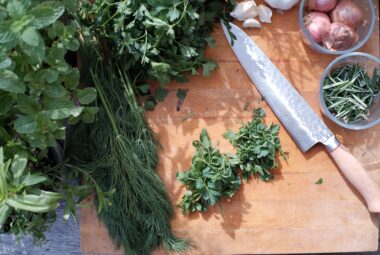 Harvesting and Utilizing Your Herb Garden
Harvesting and Utilizing Your Herb Garden
The reward for your dedicated care and attention arrives when it’s time to harvest your herbs. Timing is crucial for the best flavor and potency. Herbs are at their best just before they flower, so harvest them when they’re lush and full but haven’t yet produced blooms.
The uses of your harvested herbs are limited only by your imagination. Enhance your culinary creations with fresh basil, oregano, or cilantro. Create soothing herbal teas with mint, chamomile, and lemon balm. You can even experiment with crafting homemade herbal remedies, harnessing the healing properties of herbs like lavender and sage.
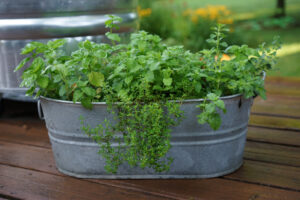 Vertical Herb Gardens in Small Spaces
Vertical Herb Gardens in Small Spaces
Not blessed with a sprawling garden? No problem! Vertical herb gardens are particularly well-suited for small spaces. Whether you live in an apartment with a tiny balcony or a cozy studio, you can still enjoy the delights of herb cultivation. Embrace container gardening and make use of walls, railings, or even window boxes to create your green oasis.
Vertical Herb Gardens as Decorative Elements
Beyond their practical benefits, vertical herb gardens can serve as stunning decorative elements. Infuse life and vitality into indoor spaces by adorning walls with cascading herbs. Outdoors, transform blank walls or fences into captivating displays of nature’s splendor. Your vertical garden isn’t just a source of herbs; it’s a living, breathing piece of art that elevates the ambiance of any setting.
Sustainability and Environmental Impact
Vertical herb gardens contribute to a more sustainable lifestyle. By growing your herbs at home, you reduce the need for commercially grown produce that often requires long-distance transportation and excessive packaging. Additionally, cultivating a diverse range of herbs encourages biodiversity, creating a miniature ecosystem that attracts beneficial insects and supports pollinators.
Cost-Effectiveness
Embracing a vertical herb garden isn’t just an aesthetic endeavor; it’s also an economically savvy choice. Consider the money you’ll save on store-bought herbs – no more buying bundles of herbs only to use a fraction and watch the rest wilt away. With your vertical garden, you can snip as you go, ensuring you only use what you need. The minimal investment in equipment and soil is outweighed by the abundant harvests and long-term benefits.
Embarking on the journey of cultivating a vertical herb garden is a rewarding endeavor that combines functionality, aesthetics, and environmental consciousness. Whether you have a sprawling outdoor space or a modest balcony, the joy of nurturing your herbs and enjoying their flavors is wonderful.
FAQs
Can I create a vertical herb garden indoors? Absolutely! Indoor vertical herb gardens are a fantastic way to bring nature into your living spaces. Choose herbs that thrive indoors and position your garden near a sunny window.
Do vertical herb gardens require a lot of maintenance? While vertical gardens do require maintenance, their accessibility and design can make the process more convenient. Regular watering, pruning, and watching for pests are essential tasks.
What’s the best way to prevent herbs from becoming overcrowded? Overcrowding can affect the health of your herbs. To prevent this, ensure proper spacing during planting and be prepared to replace tired or overgrown plants with fresh ones as needed.
Can I use a vertical herb garden for medicinal herbs? Absolutely! Vertical gardens are an excellent way to cultivate medicinal herbs like lavender, chamomile, and echinacea. Just ensure you research each herb’s specific needs and uses.
How can I make my vertical herb garden a decorative focal point? Incorporate decorative elements such as colorful planters, creative arrangements, and even small decorative ornaments that complement the theme of your garden and enhance its visual appeal.
